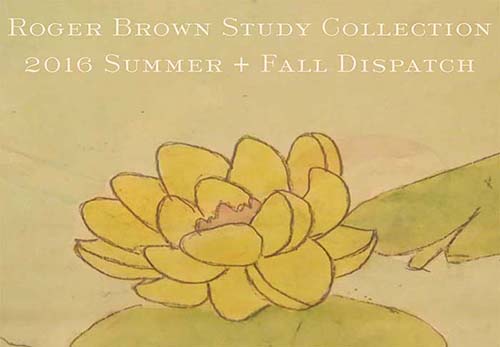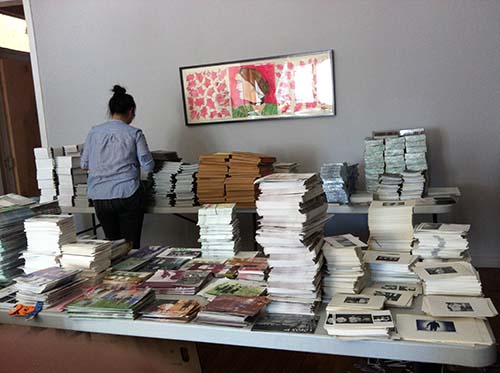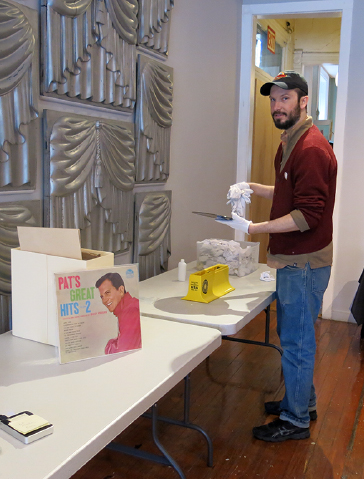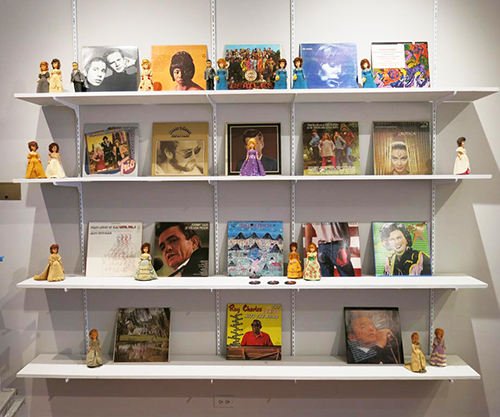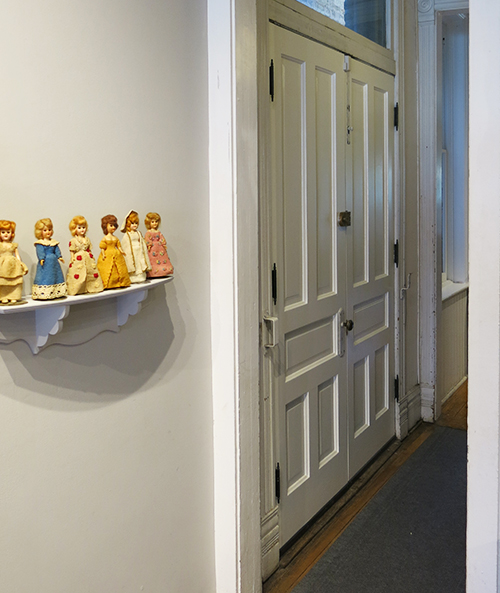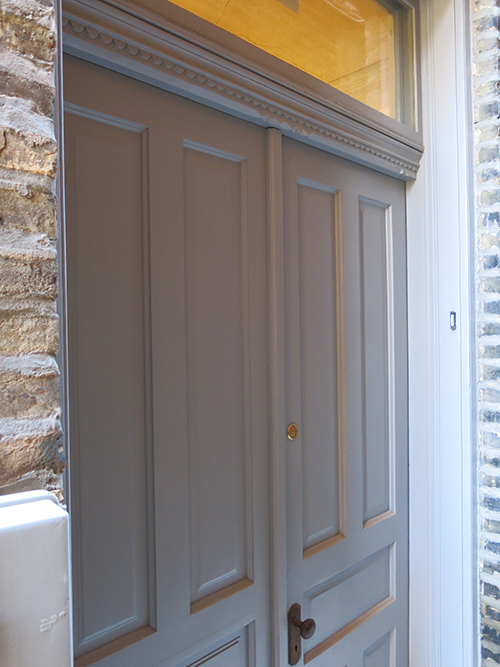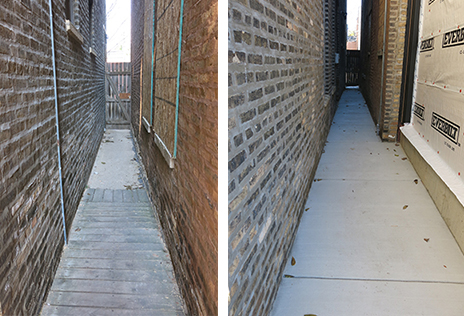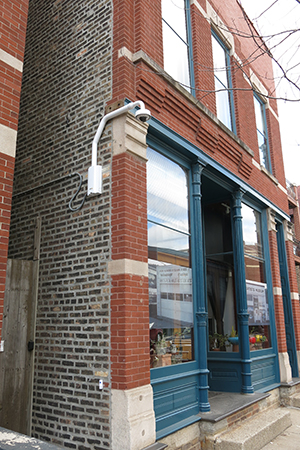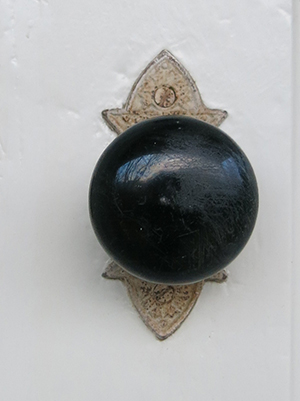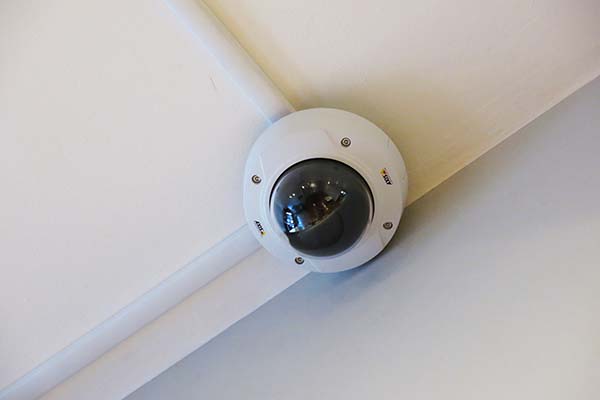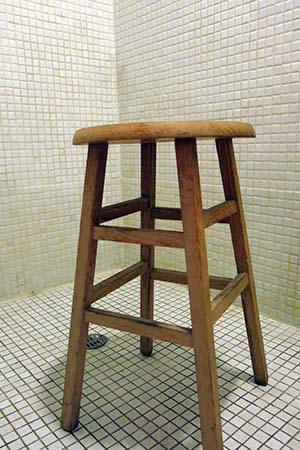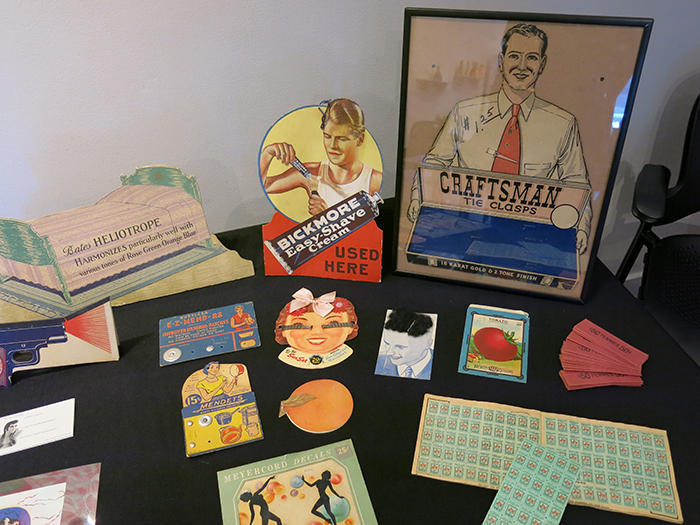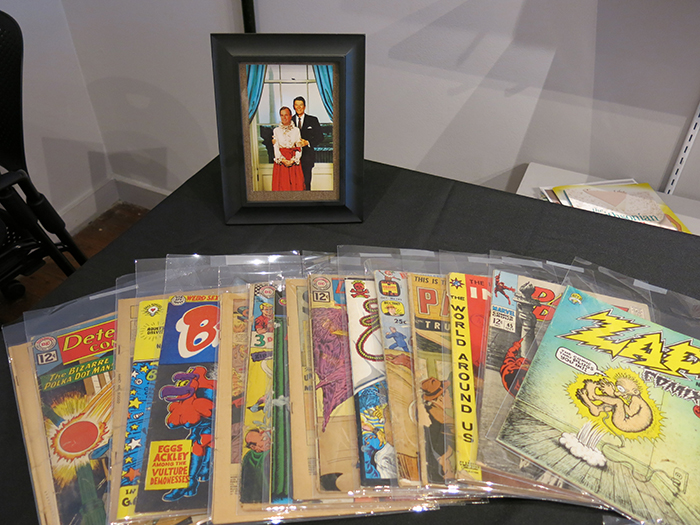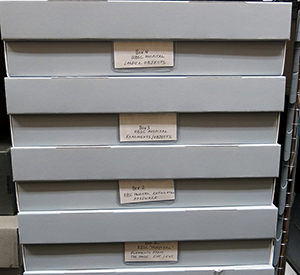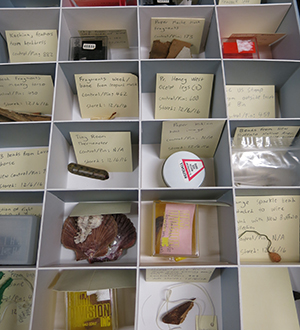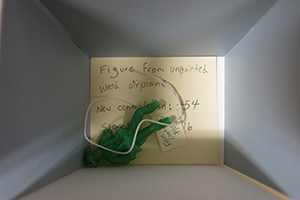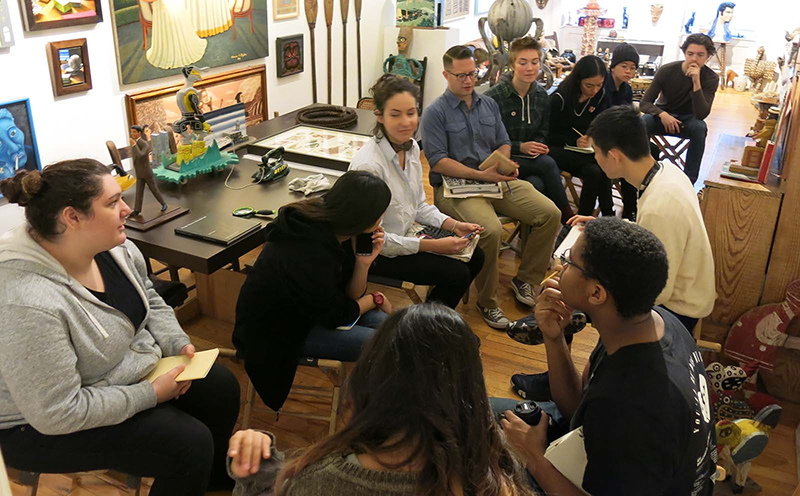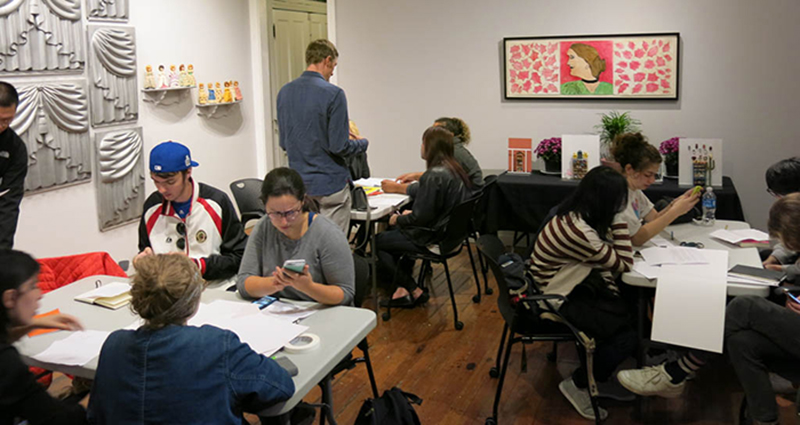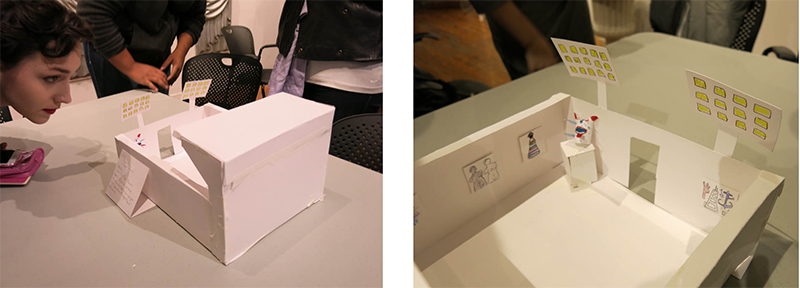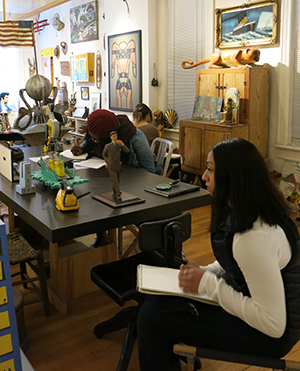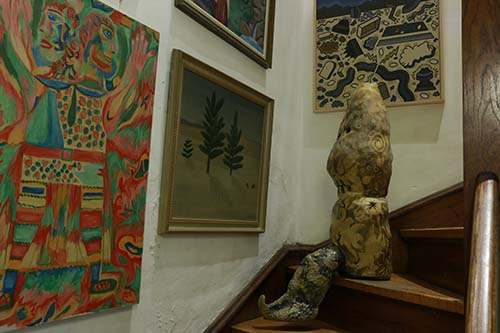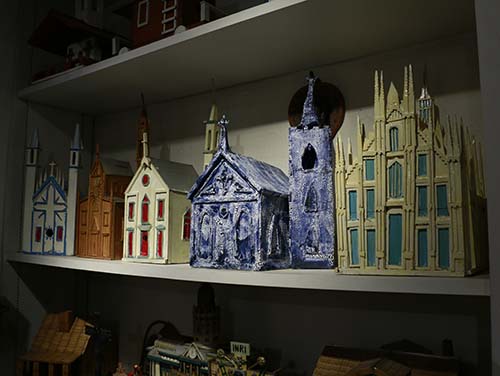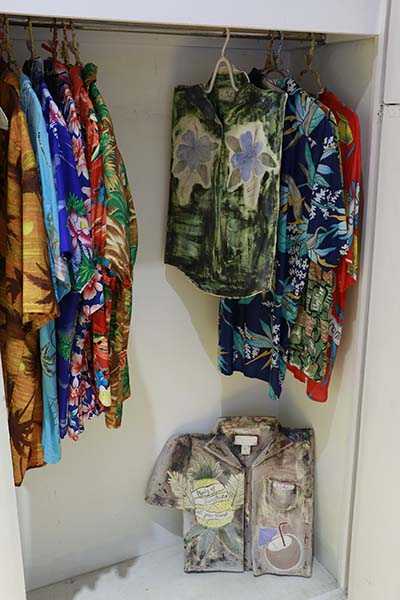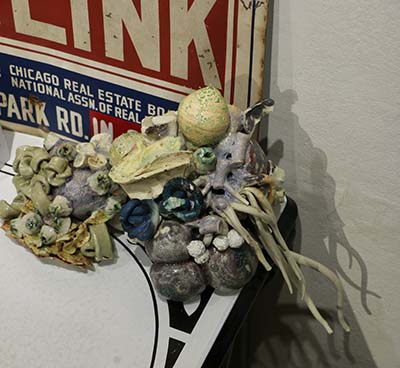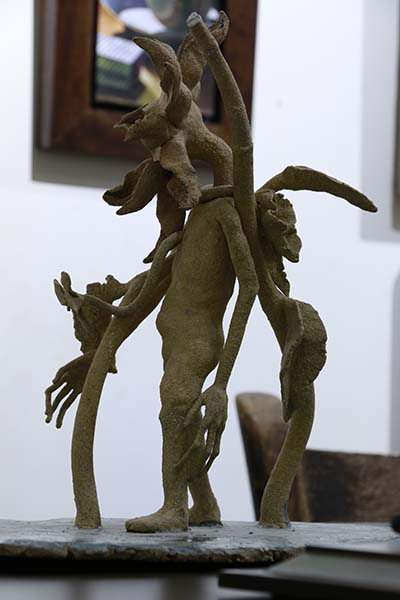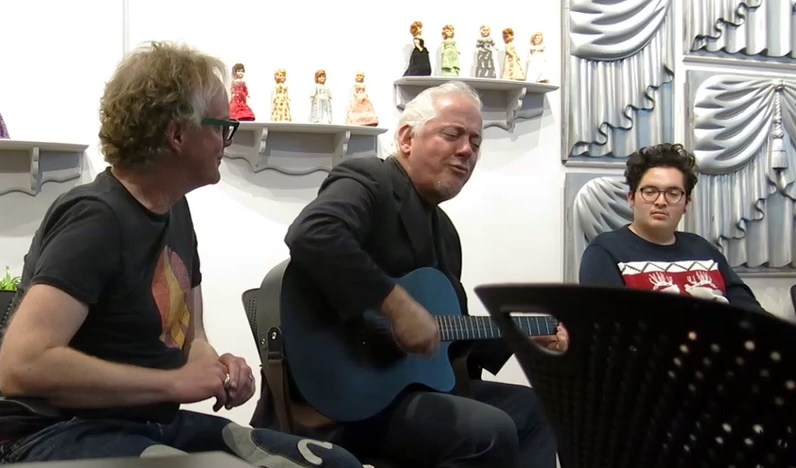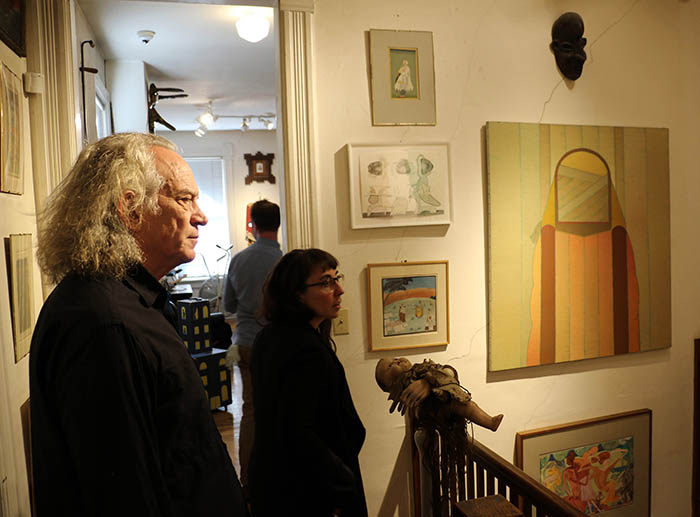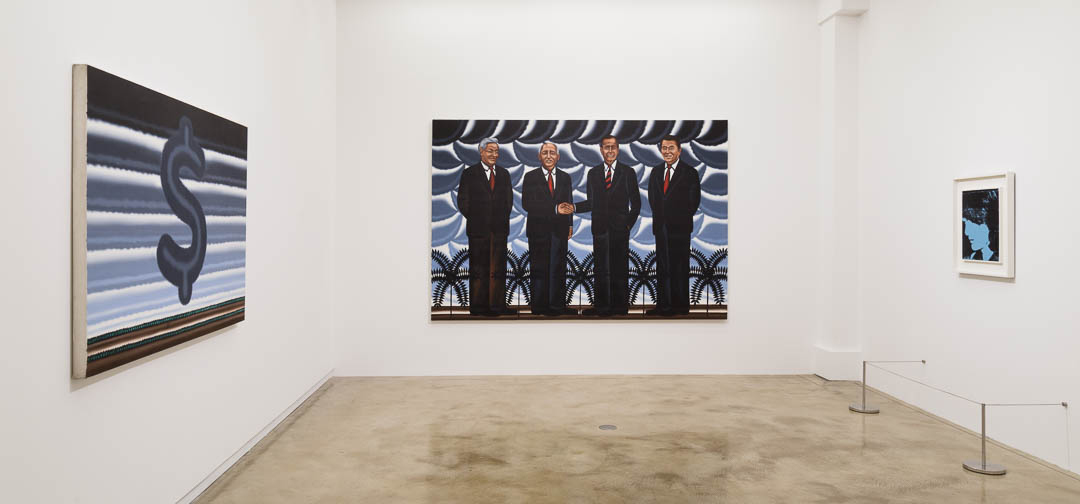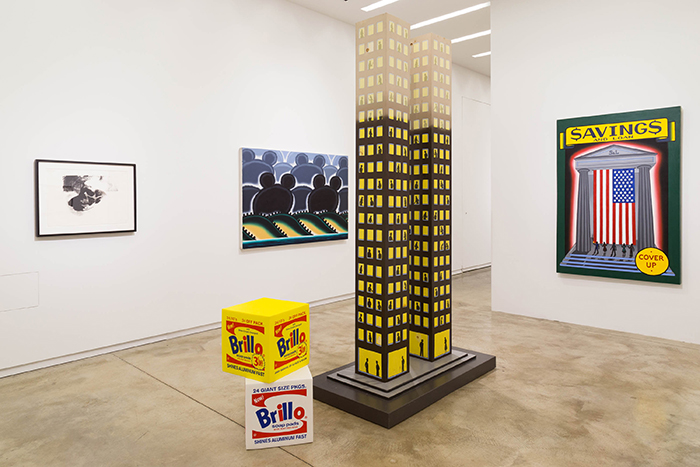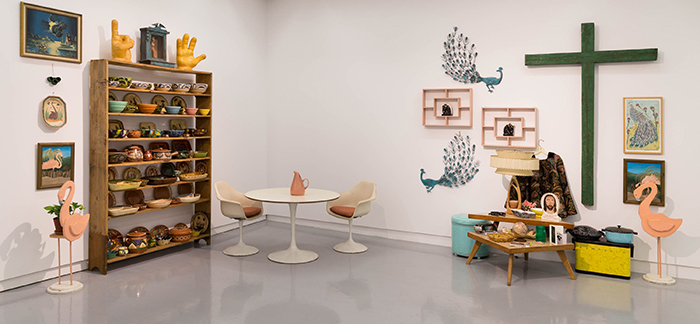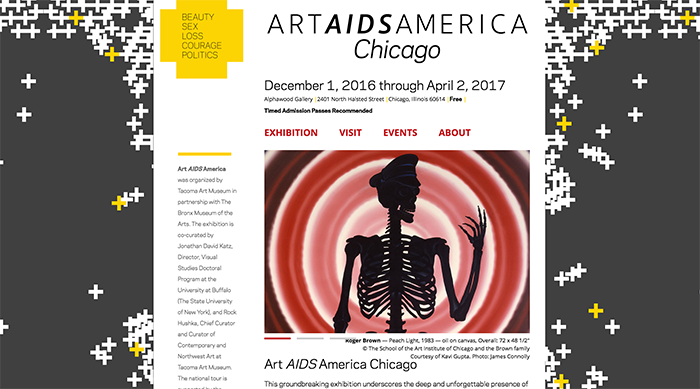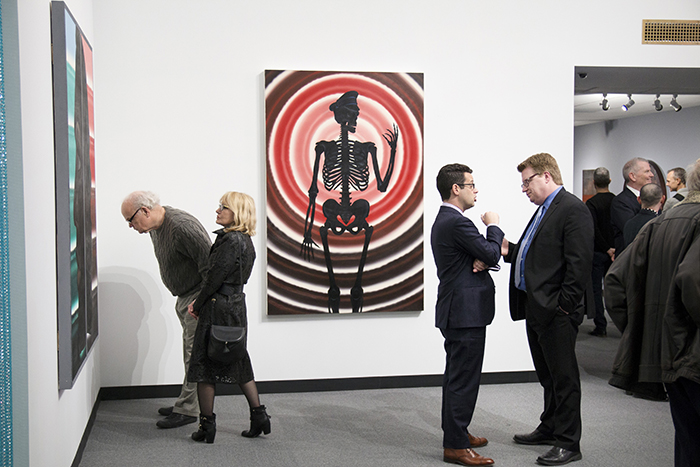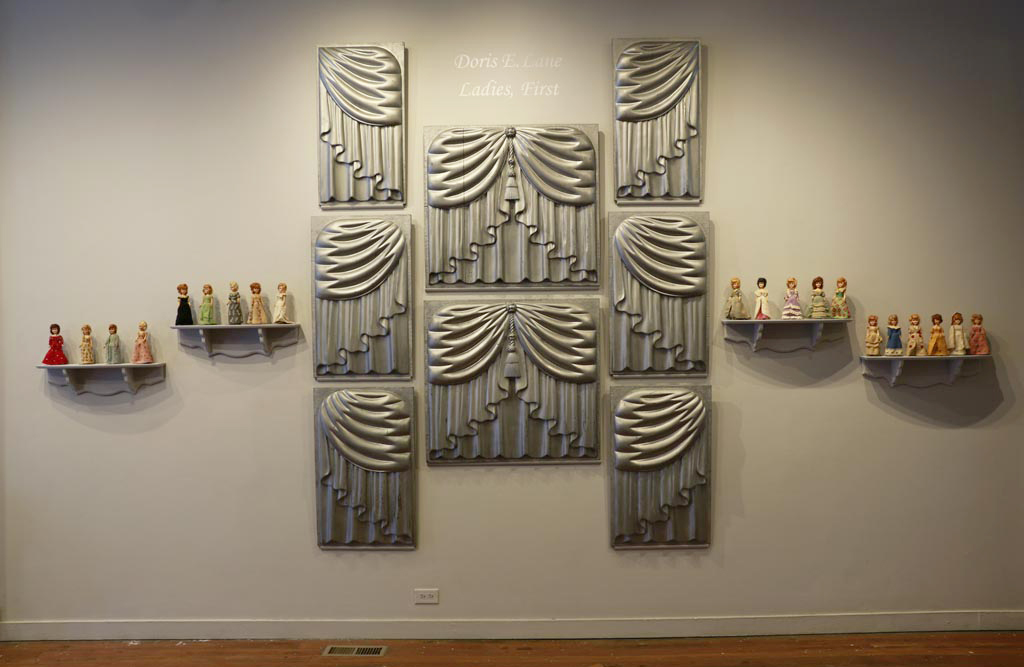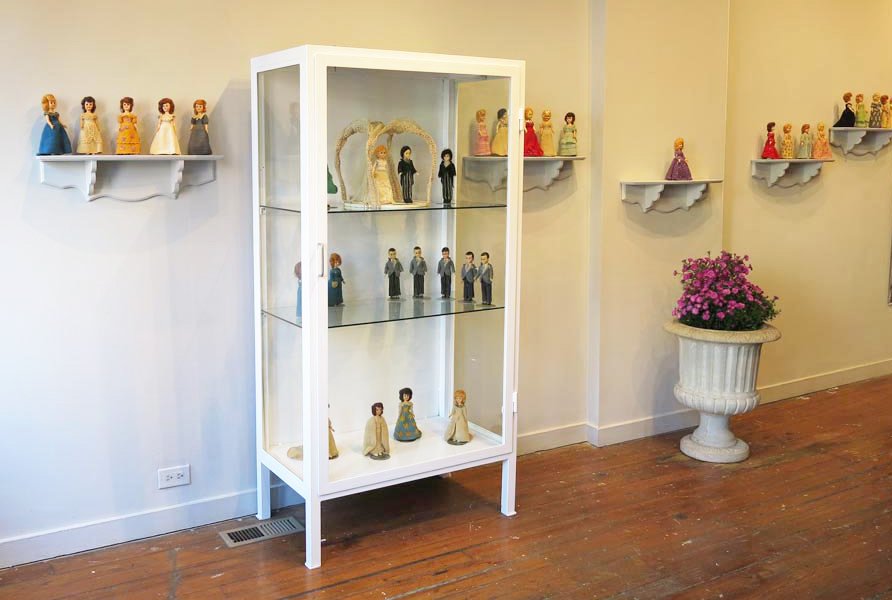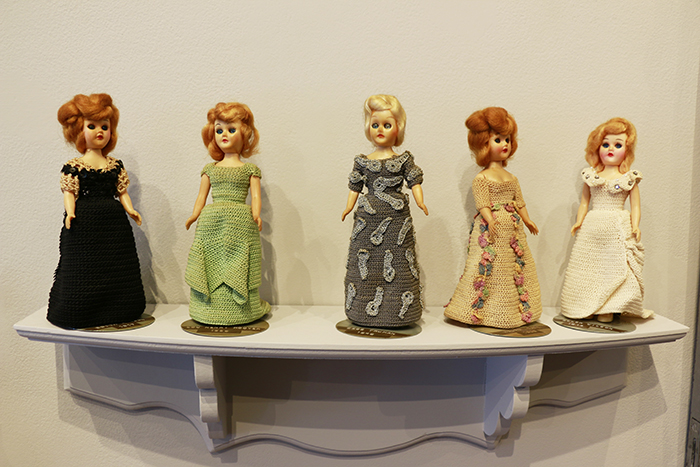Roger Brown Study Collection Summer+Fall 2016 Dispatch
Friday, December 23rd, 2016 » By lstone » See more posts from ALL THE NEWS
Lots has happened this year, here at the Roger Brown Study Collections,
which Ben Nicholson elegantly described as a formal garden of inorganics.
Ben’s formal garden analogy is apt for the collection,
which remains arranged as Roger planted it.
In terms of our work here, we’ve been doing a lot of weeding in the back 40…
Here’s what we’ve been up to:
summer
In May and June we closed the orientation/project space to make room for a Special Collections project. Nick Lowe worked with Arts Administration grad student Flora Zhang, on the complete organization of the 32 year archive of the Goat Island performance collaborative.
They archived up a storm, resulting in the organization of diverse materials including video and photo documentation, international and national performance communications and ephemera, and costumes and props. The collection was moved to the Flaxman Library and officially became an SAIC Special Collection.
RBSC staff had much-awaited quiet time to work on collections. James Connolly oversaw staff on the ongoing project to advance the Master RBSC collection database, locating and photographing many hundreds of objects and entering info and images.
Volunteer Kurt Peterson cleaned most of Roger’s ~ 300 vinyl LP record albums, from the 1926, New Buffalo, and La Conchita collections, and began the digitization process. Staff member Matias Anon spent the summer digitizing all the albums.
We mounted a selection of “staff picks” on the Yoshida shelves this fall. Each class that visited selected 2-3 albums for their playlist while in the collection. The albums were played upstairs through the Sonos speakers. We kept track of all album selections throughout the semester. Nina Simone and Johnny Cash are definitely trending!
1926, the building
The project to restore the doors, windows, transoms, and install new, wood-framed, uv filtering storms on all windows was completed this fall.
As more and more buildings in the neighborhood are demolished and the streetscape evolves, 1926 continues to connect the past with the future. At 1926 the histories of the 19th century building and a 20th century artist are performing fully into the 21st century. We’re committed, as always, to enacting historic preservation as a creative activity.
The plan to remove the crumbling wood ramp and renovate the sidewalk, and east and west doors, for improved, ADA compliant access was scheduled for 2017. Major construction on the property next door accelerated this project. The new sidewalk and ramp is a major improvement.
A security camera and accessible doorbell were installed.
Sincerest thanks to the Walter and Karla Goldschmidt Foundation
for their generous support of these projects!
As always, huge thanks to SAIC’s Instructional Resources Facilities Management team,
Tom Buechele, Ron Kirkpatrick, Mike Plummer, Colette Tam, and Rachel Krcmarich,
for their ongoing care of 1926. Speaking of which,
We got I-T done!
All electronic communications and security systems were completely upgraded at 1926. The project vastly improved our internet connectivity, for RBSC staff and all the classes that use it. Thanks to Kevin Lint, Brian Werle, and Jeff Panall for making this happen.
Good House-Museum Keeping
Garage: cleaned and rat proofed!
Bathroom shower: Had been an “archive” space for years, with wire shelves and archival textiles stored there. All were removed and it’s back to being a bathroom shower, to our great relief.
Archive
We struggle to keep ahead of researchers’ queries and requests, but the archive has the knack for keeping ahead of us. We got serious in late November and relocated a van-load of materials that we don’t need regular access to, to offsite storage, freeing up our heads and much needed space.
All unprocessed materials were identified and prioritized for processing. Gabe, Flora, and Xin are all working on processing archival materials, adding descriptions to our finding aid, filing and/or re-housing them.
The Chicago Area Archives consortium held its second annual Chicago Open Archives event in October. We opened the RBSC for tours and put out a spread of very excellent ephemera.
The RBSC St. Honey West Fragment Hospital
For years lost limbs, detached fragments, broken pieces, and bits + bobs were cataloged and stored in the St. Honey West RBSC Archive Hospital – named (by former student staff member Lisa Abbatomarco) after the vampy 1966-67 TV show. Roger acquired two Honey West accessory cards, which can be seen, if you’re on your hands and knees, in the Yoakum Room curio cabinet. The hospital was located in an old bankers box; the wards were overcrowded and, well, inhospitable.

Left: the real Honey West. Right: the old St. Honey West Hospital, and Honey West memorabilia in the RBSC.
Hospital expansion project
We demolished the old hospital to make room for a new 5 story, archivally sound Fragment Hospital.
Roger Brown’s Sketchbooks!
We worked with Flaxman Digital Librarian Chris Day and his stellar staff, who completed the project to make the digitized versions of all (22) of Roger Brown’s sketchbooks accessible online. The sketchbooks reveal the origin and development of Brown’s creative process, providing insight into his ideas, from his student years to his final works. Enjoy this trove of stunning drawings, invaluable in the interpretation of the resulting artworks, as well as revealing ideas that never went further than a sketch. You can access them here: Roger Brown’s sketchbooks.
Programming: who came and what they did
We hosted approximately 1900 guests this year, with 86 SAIC class visits, 54 in fall semester. Following are views of some highlights from the autumn onslaught of SAIC students, faculty, and other august guests.
Each fall Ceramics professor Patricia Rieger brings her Curious, Intimate Objects class to explore the collection and connect with a place and/or objects within. The students then make works based on this research and install them throughout the collection and property, for an all day critique. Following are a few examples of many wondrous responses to our formal garden of inorganics.
Legendary artist/musician Jon Langford serenaded Peter Exley’s Research Studio students with Mekons’ hit White Riot.
Exhibitions
We extend sincerest thanks for the enormous amount of energy, acuity, creativity, rigor, and resources that the Kavi Gupta team poured into the fall exhibition, Roger Brown & Andy Warhol: Politics, Rhetoric, Pop! The show was insightfully curated and interpreted, and augmented by three panel discussions with an outstanding roster of artists, scholars, critics, and curators, including John Yau, Lisa Wainwright, Dan Nadel, Katherine Andrews, Greg Brown, Russell Bowman, Chloe Pelletier, Jonathan Odden, Will Simmons, and David Getsy. The second floor gallery included five arrangements from Brown’s La Conchita, California home, examples of Brown’s object paintings, and a selection of catalogs, exploring Brown’s and Warhol’s collecting proclivities. The project went far to present Brown’s work in a previously unexplored context and we applaud their efforts to widen perceptions of Brown’s work.
ArtAIDSAmerica
We are honored that that two paintings from the Roger Brown estate are included in the Chicago exhibition of ArtAIDSAmerica. Organized by the Tacoma Art Museum, the show was expanded to include several Chicago artists and is on view in a space created specifically for the exhibition by the Alphawood Foundation, under the direction of Anthony Hirschel. We extend congratulations and thanks to Tony and Alphawood staff.The exhibition is deeply moving, not to be missed. ArtAIDSAmerica, Alphawood Gallery, 2401 North Halsted St., December 1, 2016 through April 2, 2017.
Ladies, First
We went politically, historically, conceptually, and most fashionably correct at 1926 this fall. We were elated to unveil the modest exhibition, Doris E. Lane – Ladies, First –– a collection of dolls bedecked in the most exquisitely crocheted gowns, representing the First Ladies in their inaugural garb (plus the Tricia Nixon Wedding Party), lovingly made by Doris E. Lane.
We know little about Ms. Lane other than she was in fashion design in the Bay area and in the 1960s she began crocheting doll garments––eventually completing over 300––representing a broad range of nationalities and types of garments. She was in her mid 80s in 2010 (or thereabouts), when she donated her whole collection to the Oakland Museum of California, to be sold individually at the Museum’s White Elephant benefit sale.
The First Ladies collection was discovered by Dr. Jacqueline Fulmer, folklorist in doll history and culture in Berkeley, and rescued by our dear friends and colleagues at the Museum of Jurassic Technology in Los Angeles. Friends at the MJT graciously agreed to loan the collection to the RBSC, sharing our desire to soften the election season tension with attention to beauty and craft-of-the-highest order. The exhibition reflects Roger Brown’s ardent commitment to conjoining the so-called high style with the so-called not-so-high style, and the celebration of popular culture and popular crafts.
We extend sincerest thanks to Jackie Fulmer and Museum of Jurassic Technology friends Hana van der Steur, David Wilson, and Alexis Hyman-Wolff, and of course, to Doris E. Lane.
Brown Family
Roger wasn’t the only artist in the Brown family to fall under SAIC faculty member, artist/art historian Whitney Halstead’s spell. Greg Brown attended SAIC in the 1970s. In one of Halstead’s classes, he took the assignment to find and document excellent examples of the vernacular landscape to heart. Wandering all over creation with his radar tuned high, and camera at the ready, Greg got the goods! He allowed us to digitize 147 slides taken in 1976, and gave us the notebook logging his research. These enhance our understandings of: a) what ordinary people did to personalize their homes and gardens forty years ago, and b) Whitney Halstead’s creative, expansive teaching, and c) Roger Brown’s and Barbara Rossi’s collections of images from similar assignments. You can see Greg’s images here.
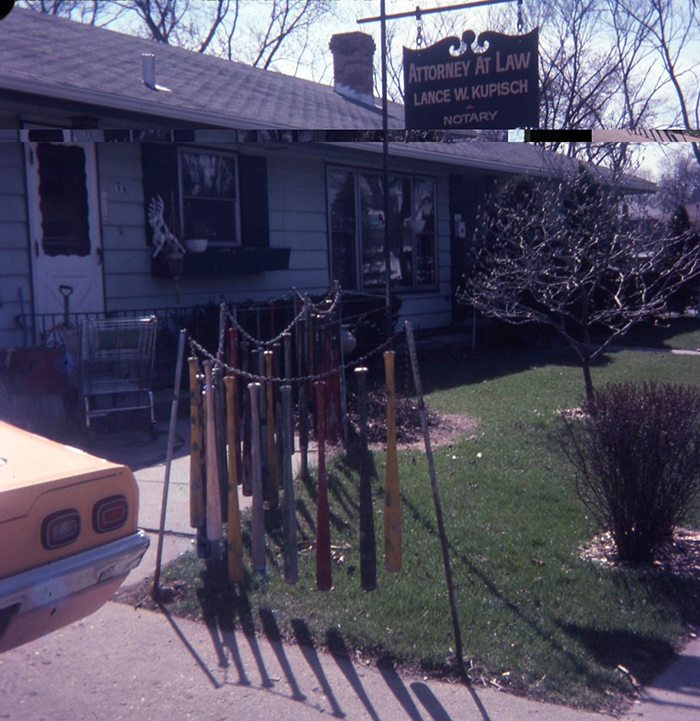
Greg Brown, photo of swinging baseball bat fence in Lance W. Kupisch, Attorney-at-Law’s front yard, 1976.
Greg also gave the RBSC an extraordinary scrap book that his mother made during 1945-46, the years her husband James served overseas in World War II. She saved the most poignant of scraps, including a napkin from Roger’s 5th birthday. Inscribed December 10, 1946, seventy years on the candles still shine.
Lisa Stone, December 22, 2016

